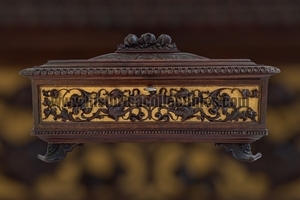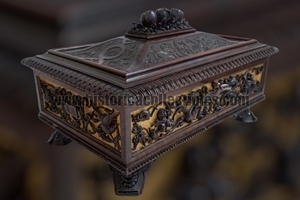Carved and Gilded Rosewood Casket by Pietro Giusti, Siena, 1869
Magnificent rectangular-shaped casket in Rosewood, with hinged lid and support feet worked in "cartoccio", carved in high and low relief, engraved and gilded by Pietro Giusti, the excellence among the most renowned designers and wood carvers, of Tuscany in the 19th century.
His knowledge of ornamental motifs combined with great virtuosity in wood carving resulted in beautiful creations such as this casket.
Pietro Giusti was born in Siena on 29 July 1822 to Gaetano, a tailor by profession, and Margherita Cenni. Widowed when her son was only six months old, his mother worked to guarantee him a certain education by resorting to private teachers, but, given the economic difficulties, already in 1834 Pietro Giusti began working as an errand boy in the shop of the printer Guido Mucci.
The salary provided him with the opportunity to study drawing at the Institute of Fine Arts in Siena with the master of ornament Vincenzo Dei. In a short time, given his propensity for drawing, he went to work, always as a messenger, in the workshop of the engraver Angiolo Barbetti - alternating as an assistant also in the workshop of the latter's father, Massimiliano Barbetti - until 1842, the year in which Angiolo moved his school to Florence, leaving the workshop to the young pupil and to another carver, Antonio Rossi.
In 1845 Giusti founded his own carving workshop and also began to have students who collaborated with him on the realization of various commissions. In 1848, like many other young Italians, he volunteered for the war against Austria; during the battle of Curtatone and Montanara (29 May 1948) he was taken prisoner by the Austrians and taken to Bohemia, where he remained imprisoned in the Theresienstadt fortress from 15 July to 29 August and then in the military hospital in Prague from 2 to 12 September. Thanks to an exchange of prisoners he was finally repatriated to Italy and arrived in Siena on 25 October 1848.
Despite the difficulties of imprisonment, Pietro Giusti left testimony in his notebook that he also enjoyed, in this period, the possibility of seeing many works of carvers in the cities visited on his return journey to Italy, works which were for him a source of inspiration for future achievements. In 1855 he was called to the position of substitute master of ornamentation at the Institute of Fine Arts in Siena, becoming holder of the chair on 19 January 1856, after the death of his master and friend Enea Becheroni.
On 30 January 1866 he left Siena definitively with his family to move to Turin, where he was called to take on the role of professor of modeling and ornamental design at the Italian Industrial Museum. In his notebook it is possible to read notes of dissatisfaction, due to the obligation to close his Turin workshop just a year after he moved there, and to the change in the Museum's teaching direction, which forced him to only teach the theory of his subject. Pietro Giusti died in Turin in 1878 (Italy).
Referenze:
- Metropolitan Museum New York: Accession Number: 1998.19
- Victoria & Albert Museum: Pietro Giusti (1822-78), Siena, carved & gilded walnut frame, International Exhibition, London, 1862; Accession Number V&A Museum 8053:1-1862
- Victoria & Albert Museum (Accession Number 7881-1861).
- Capolavori dell'arte decorativa del XIX secolo, Pipino Stampa , 2001, pp. 309, 342, 343."
- Circle of Raphael, The Holy Family with the infant St. John in a landscape, ‘The Kingston Lacy Raphael’, c.1516-17, o/panel, 30 x 21 in (76 x 53.3 cm), carved walnut frame by Pietro Giusti of Siena, 1853-6, Kingston Lacy, Dorset, NT 1257083.
Bibliography:
E. Nencioni, "Di un cofano commesso dal Conte Augusto de' Gori all'artista Pietro Giusti e da lui scolpito in avorio", Siena, Mucci, 1859
M. Lessona, "Volere è potere", Firenze, Barbèra, 1869, pp. 198-202
C. Sisi, E. Spalletti (a cura di), "La cultura artistica a Siena nell'Ottocento", Siena, Monte dei paschi di Siena, 1994, p. 341
A. Grifoni, "La vita e la produzione artistica di Pietro Giusti, Siena 1822-Torino 1878. Protagonista della fortunata stagione dell'intaglio ligneo senese", tesi di laurea, relatore prof. Giuseppe Cantelli Università degli studi di Siena, Facoltà di Lettere e Filosofia, a.a. 1993-1994
S. Chiarugi, "Botteghe di mobilieri in Toscana", Firenze, SPES, 1994, pp. 483-491
G. Borghini, "Risorgimento senese. Le opere e i giorni", in "E il vento del Risorgimento soffiò su Siena e il suo Palio", Siena, Contrada della Torre-Circolo culturale I Battilani, 2011, pp. 35-54
P. Turrini-M. V. Ciampoli, "Siena e la Costituzione toscana del 1848. Una festa per Leopoldo II, in Dal Granducato al Regno, atti della giornata di studi. Siena, Archivio di Stato, 3 marzo 2011", a cura di P. Turrini-E. Pellegrini, «Accademia dei Rozzi», XX, n. 38, pp. 5-27, in particolare p. 11.


